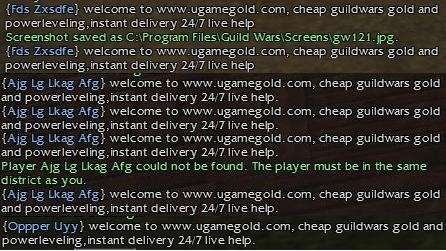
Featured Blog | This community-written post highlights the best of what the game industry has to offer. Read more like it on the Game Developer Blogs or learn how to Submit Your Own Blog Post
Focused Communication and Communities in Games
How can you foster a community in your game naturally and without irrelevant conversation or toxicity?

Communities that arise from communication between players about or within the context of a game can be extremely beneficial forces in creating an enjoyable play experience. However, the catch in providing communication between players in games is designing systems to exclude harassment, bullying, and other toxicity, as well as keeping the conversation relevant to the game itself. The obvious solution to provide a line of communication between your players is to provide a chat function, but frankly I don't need to write an essay on how that turns out:



Don't get me wrong, I agree that text and voice chat are in some situations beneficial if not necessary to facilitate trade, strategizing, and discussion. However, regardless of what you're opinion of chat is, or what mechanics you implement to restrict toxic communication, we as game designers can't change the way people express their negative opinions, we can only punish them, which isn't a preventative measure. It's important to explore alternative forms of player communication and interaction more relevant to your game to foster a focused community that preserves the importance of social interactions, interpersonal emotions, and strategies that arise as a result of communication.
Hearthstone: Removing Chat Between Competitors
The first game that really got me thinking about replacing chat with other communication mechanics was Hearthstone. After spending a year playing World of Warcraft, League of Legends, and DotA somewhat competitively, I was sick of the boasting, the arguing, and the harassment that plagues that chat features in those games. Frustration is often what causes a player to speak his/her mind, and often backwards rationalization and blame projection cause argumentative behavior when things aren't going well for a player or team. When started to get into Hearthstone, the silence was glorious. Blizzard cuts off all chat between you and the opposing player, because there's nothing to talk about. All the chat that would occur is insults, small talk, or lies, because there's nothing to fuel a game-relevant conversation between two competing players. I could focus on the game, I was fully aware that any mistakes were my own fault, and I didn't have anyone screaming in my ear that I was playing the wrong way or insulting my mother. This mechanic is clearly a conscious choice by Blizzard; the chat functionality exists between Battle.net contacts, meaning I can talk with my friends while in-game, but I don't need to talk with my opponent.

However, some card game players would argue that there is skill associated with the social mechanic of being face-to-face and talking with another player. Like poker, reading facial expressions, verbal and visual cues, and manipulating emotions and thoughts are part of the game. For this reason, Blizzard implements mechanics to replace the absence of chat. For one, they included a very structured form of verbal communication through emotes that only apply to specific game situations, keeping the chatter minimal and relevant:

To prevent what little spam and harassment is possible as a result of this system, emotes share a cooldown and opponents can be "Squelched" to silence future emotes.
Additionally, to digitally simulate "reading" an opponent's behavior, Blizzard implemented a graphical system that highlights the cards your opponent hovers over:

A player could use this to make guesses as to which cards his opponent is considering playing by keeping track of which cards they hover over in their hand, or which cards in play the opponent is concerned about.
League of Legends: Positive Reinforcement and Graphical Warnings
League of Legends has been poisoned with serious player toxicity issues since the early phases of public testing, and Riot has tried several different methods of encouraging focused communication and discouraging negative behavior. Aside from allowing players to disable communication with the enemy team to squelch harassment and boasting, two major features implemented by Riot caught my eye as noteworthy mechanics for fostering a positive community.
League of Legends' Honor system is an attempt at a player-driven source of positive reinforcement for friendly and focused player behavior as an alternative to the punishment system of reporting a player for toxic behavior. At the end of the game, you can award a player Honor in various formats regarding teamwork, leadership, attitude, and helpfulness:

For additional motivation, players that receive Honor repeatedly receive visual effects on their player portraits reserved for the most positive players in the game. The implementation of this system undoubtedly had a beneficial effect on player behavior, but is still not a preventative measure, only a suggestive one.
Riot also implemented a feature that serves as an alternative to communicating through chat called Smart Pings that allows players to notify their teammates contextually through a locational warning that appears graphically on their minimap and on the game terrain. Clicking and holding the ping button will create a radial menu that pings the selected warning where the click occurred:


Again, this system is not a preventative measure against toxic chat and behavior, it provides an alternate form of communication that encourages focused communication between teammates and is without doubt a step in the right direction.
Dark Souls 2: A Sense of Community in a (Mostly) Single Player Game
With Dark Souls 2, Namco Bandai Games extended the player interaction of Dark Souls that allowed players to assist one another through messages and warnings as well as temporarily assisting each other in certain situations. By expending a consumable item, players can summon other players into their games to overcome a challenge and reward the summoned player:

The game provides no direct line of communication between the two players, but the challenge presented by the game design and the room for reward encourages both players to face the challenge ahead together. Players can also join other users' worlds to engage in PvP combat, or use other consumable items to interact with other players in various alternative ways.
The minimal form of text communication Dark Souls does provide its users takes the form of warning messages that appear in the game world and can be publicly read. Players can choose to leave a warning on the ground at a particular position on the game map, and other players can find that message and interact with it:

The message could be useful or deceiving, but because it costs a consumable item to use, players rarely waste their resources on worthless, irrelevant spam. Additionally, players can rate these messages to let other readers know how valuable they are. Also, bloodstains on the ground reveal visually a player's last mistakes before they died, so that the viewer is warned of the potential challenges ahead:

Overall, Namco Bandai Games provides so many unique mechanics for player interaction and communication aside from constant text chat that it forms a unique sense of community focused on the game in an otherwise single-player environment.
Journey: The Extreme Case
There's always an extreme case that's worth examining, and in this case it's Journey, which implements a multiplayer experience but provides minimal mechanics for interaction or communication with other players. In Journey traveling with a friend only provides minimal advantages. Communication exists only in the form of an emote and movement signals. The difficulty isn't changed, you can't strategize with them, and there are minute mechanical boosts when a buddy is nearby (small movement, jumping, flight bonuses). However, accomplishing things with a friend is just for some reason more powerful. Completing or failing the journey somehow has a different or greater emotional impact when you're standing on the victory block or holding each other at the end of all things.

Read more about:
Featured BlogsAbout the Author(s)
You May Also Like







.jpeg?width=700&auto=webp&quality=80&disable=upscale)








